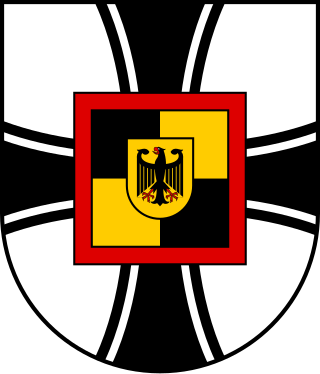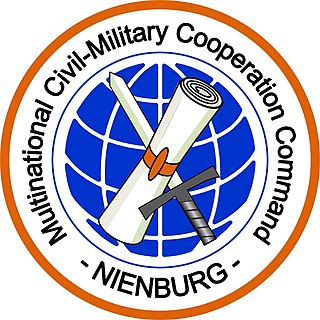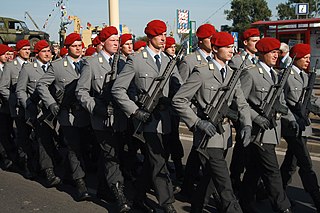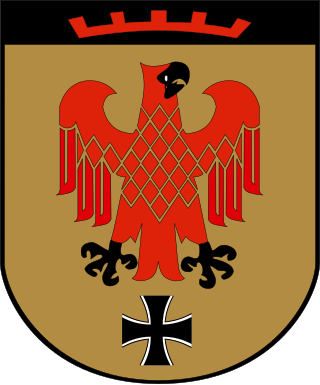
The German Army is the land component of the armed forces of Germany. The present-day German Army was founded in 1955 as part of the newly formed West German Bundeswehr together with the Marine and the Luftwaffe. As of 2024, the German Army had a strength of 63,047 soldiers.

The Kommando Spezialkräfte (KSK) is a special forces unit and a large brigade-level unit of the German Army for special operations and commando warfare, reconnaissance, counterterrorism, combat search and rescue as well as military advisor. The KSK is under the command and control of the Rapid Response Forces Division (DSK) when on routine duty and is stationed in the Graf Zeppelin barracks in Calw, Baden-Württemberg.

The Federal Ministry of Defence, abbreviated BMVg, is a top-level federal agency, headed by the Federal Minister of Defence as a member of the Cabinet of Germany. The ministry is headquartered at the Hardthöhe district in Bonn and has a second office in the Bendlerblock building in Berlin, which is occasionally used as a metonym to denote the entire Ministry.

The Joint Support and Enabling Service is a branch of the German Bundeswehr established in October 2000 as a result of major reforms of the Bundeswehr. It handles various logistic and organisational tasks of the Bundeswehr. The SKB is one of six components of the Bundeswehr, the other five being the Army, Navy, Air Force, the Joint Medical Service, and the Cyber and Information Domain Service. As of April 2020, the force is composed of 27,840 personnel. In May 2021 the minister of defense Annegret Kramp-Karrenbauer together with inspector general Eberhard Zorn published a plan to dissolve the Joint Support and Enabling Service and to reintegrate its units into the army, navy, airforce and cyber command.
The German special forces include the Special Operations Forces of the German Army and the Naval Special Forces Command of the German Navy. Both are regular units and fully integrated into the branches of the German Armed Forces (Bundeswehr). During operations, special forces personnel are under the command of the special operations division of the Armed Forces Operations Command in Potsdam, a branch of the Joint Support Service (Streitkräftebasis).

The National Cyber Defence Centre is a cooperation, communication and coordination platform of German Federal agencies and other institutions from different ministries dealing in particular with cyber-related matters of nationwide relevance.

The Kommando Landstreitkräfte was the Army staff — and simultaneously the Army command of the National People's Army (NPA) Land Forces of the former GDR.

The Air Force Forces Command, previously the Air Fleet Command from 1970 to 2001, was a high command authority of the German Air Force of the Bundeswehr, responsible for the operations of the Air Force. In 2013, it was disbanded after its functions were merged into the new Air Force Command, along with those of the other high command bodies of the German Air Force.
This article represents the structure of the Austrian Armed Forces since April 2019:
The following lists German active and reserve units within the structure of the German Army. Reserve units do not possess any heavy equipment and their personnel is intended as replacements for losses sustained by regular units.

The Armed Forces Staff, in the meaning of General staff, of the German Bundeswehr was the central department of the Federal Ministry of Defence (MOD) in direct subordination to the Inspector General of the Bundeswehr and one of the five staff headquarters in the military command of the German Bundeswehr.

The Multinational CIMIC Command, is the fourth generation of Civil-military co-operation of the Bundeswehr. The first predecessor was already formed in 2001 out of parts of the German Army (Heer), the German Air Force (Luftwaffe) and the German Navy (Deutsche Marine) as part of the Joint Support Service (Streitkräftebasis) at the Clausewitz-Barracks in Nienburg, Lower Saxony. In 2017 it employs around 200 soldiers and Civil Servants Additional to this the centre receives support by the local state commands (Landeskommando) of the States of Germany (Bundesländer) and the academy of the Federal Office for Civil Protection and Disaster Assistance in Bad Neuenahr.

The Kommando Territoriale Aufgaben der Bundeswehr short (KdoTerrAufgBw) "Bundeswehr Territorial Tasks Command" of the Bundeswehr is based in the Julius-Leber- Kaserne (Barracks) in Berlin-Wedding was founded in 2013 and is in charge of all territorial tasks of the forces as well as for the support of the civil administration.
Friedrich Boetzel was a Brigadier general of the army of the Bundeswehr. During World War II Boetzel was an intelligence officer who was Director of Operations of the Cipher Department of the High Command of the Wehrmacht from 1939 to 1943. His cover name there was Bernhard

The Fernmeldetruppe is the military communications arm of service in the German Army and in the Joint Support Service of the Bundeswehr. The Fernmeldetruppe is one of the Combat Support arms. The Army Telecommunications Force is responsible for the operation of the Army's communications and information network.
This article represents the structure of the Swiss Armed Forces as of 1 January 2018:

The Strategic Reconnaissance Command is the central headquarters for military intelligence of the German Bundeswehr, based in Gelsdorf.

The Operational Command of the Bundeswehr (EinsFüKdoBw) in Schwielowsee near Potsdam is a Bundeswehr headquarters responsible for operational missions. It is directly subordinate to the Federal Ministry of Defence, and has been directly subordinate to the Inspector General of the Bundeswehr since April 1, 2012. It was established in 2001.













